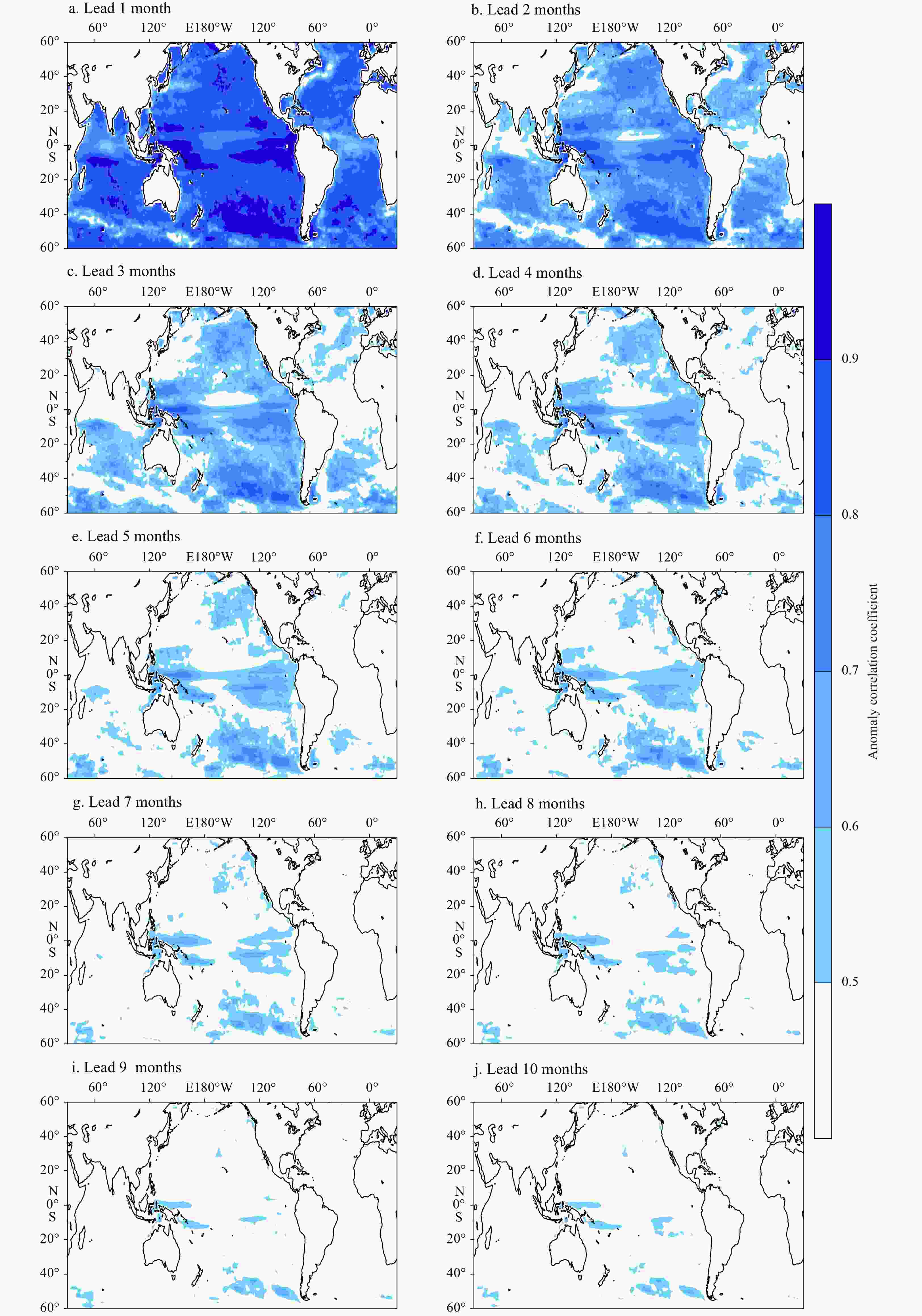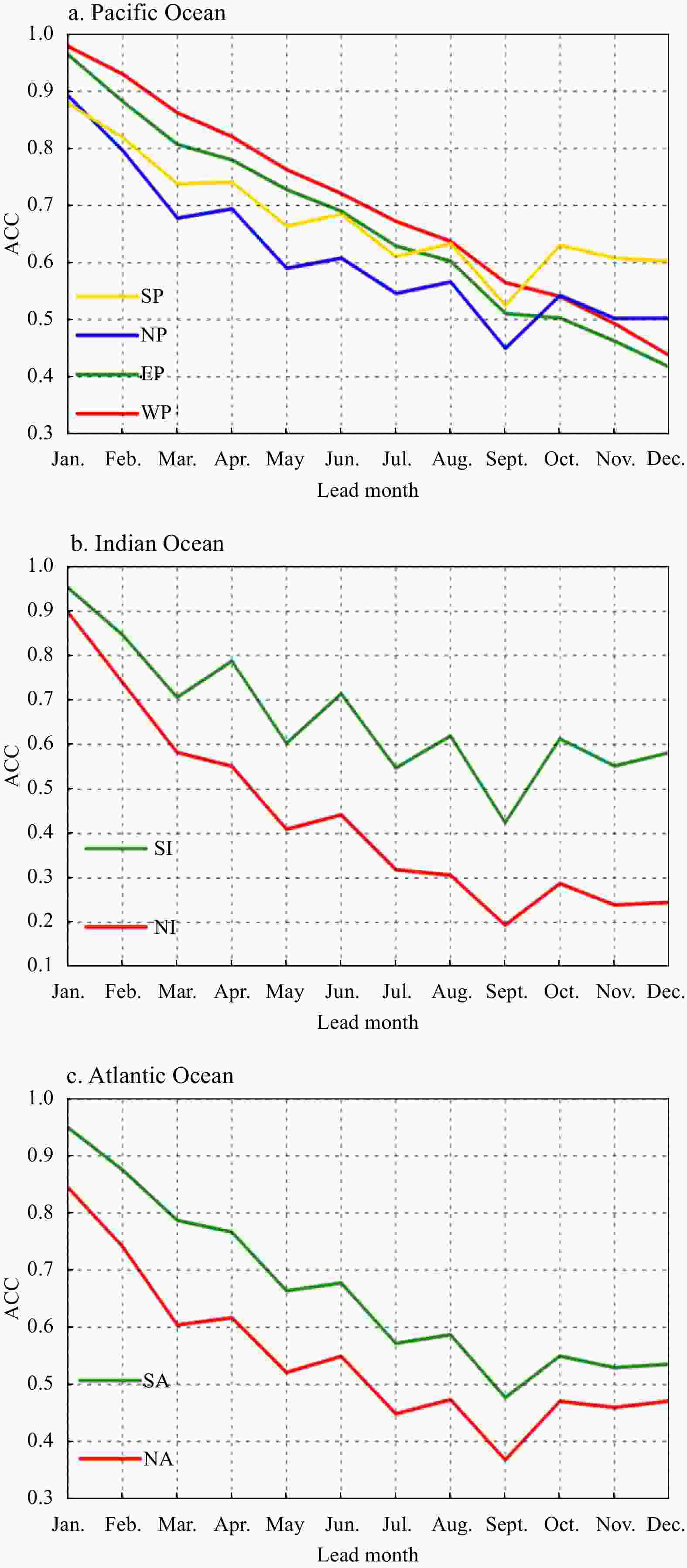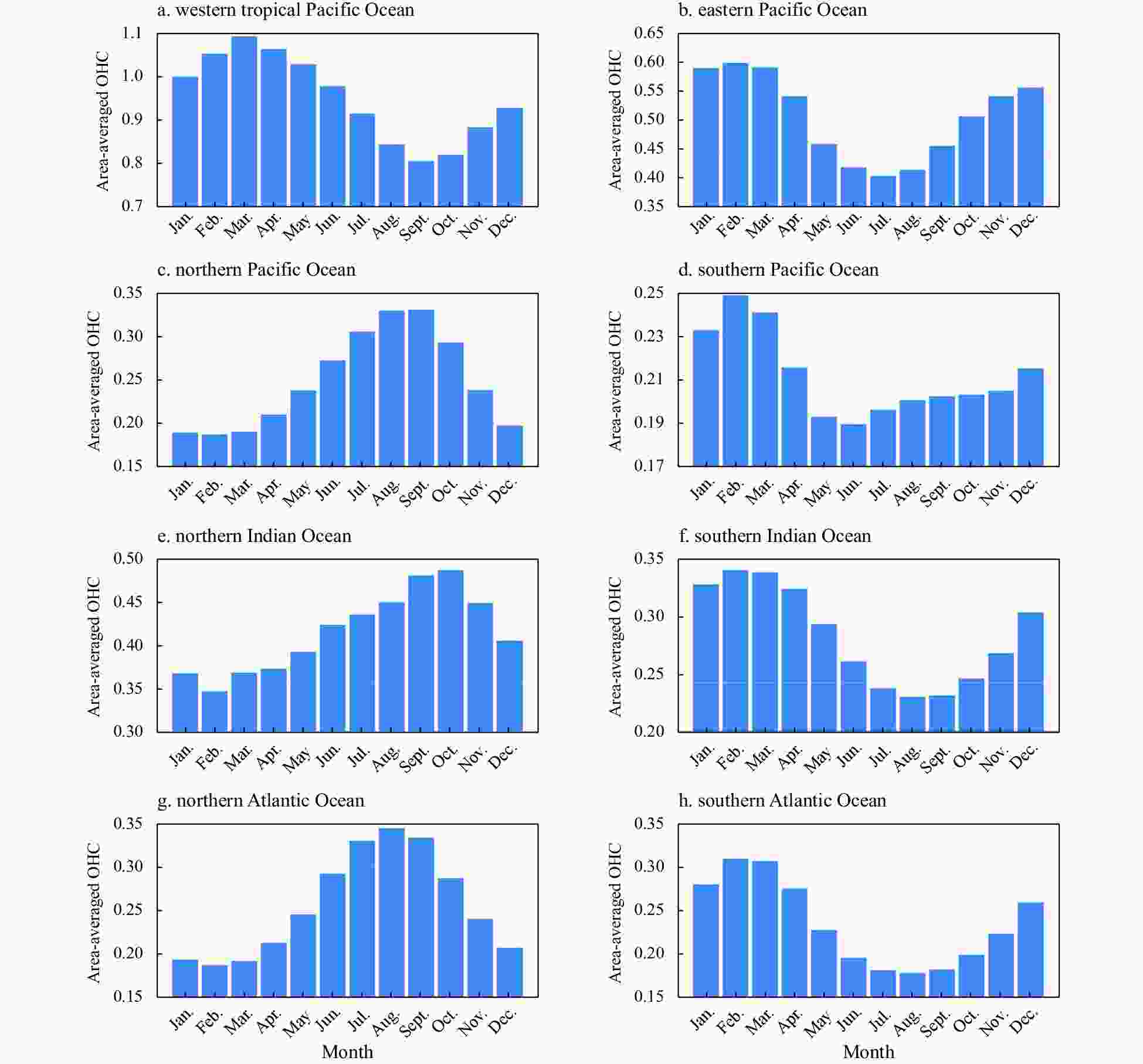Predictability of the upper ocean heat content in a Community Earth System Model ensemble prediction system
-
Abstract: Upper ocean heat content (OHC) has been widely recognized as a crucial precursor to high-impact climate variability, especially for that being indispensable to the long-term memory of the ocean. Assessing the predictability of OHC using state-of-the-art climate models is invaluable for improving and advancing climate forecasts. Recently developed retrospective forecast experiments, based on a Community Earth System Model ensemble prediction system, offer a great opportunity to comprehensively explore OHC predictability. Our results indicate that the skill of actual OHC predictions varies across different oceans and diminishes as the lead time of prediction extends. The spatial distribution of the actual prediction skill closely resembles the corresponding persistence skill, indicating that the persistence of OHC serves as the primary predictive signal for its predictability. The decline in actual prediction skill is more pronounced in the Indian and Atlantic oceans than in the Pacific Ocean, particularly within tropical regions. Additionally, notable seasonal variations in the actual prediction skills across different oceans align well with the phase-locking features of OHC variability. The potential predictability of OHC generally surpasses the actual prediction skill at all lead times, highlighting significant room for improvement in current OHC predictions, especially for the North Indian Ocean and the Atlantic Ocean. Achieving such improvements necessitates a collaborative effort to enhance the quality of ocean observations, develop effective data assimilation methods, and reduce model bias.
-
Key words:
- ocean heat content /
- prediction skill /
- retrospective forecast experiment
-
Figure 3. Anomaly correlation coefficients (ACC) for the area-averaged OHC in the Pacific Ocean (a), Indian Ocean (b), and Atlantic Ocean (c). The “EP”, “WP”, “NP”, “SP”, “SI”, “NI”, “SA” and “NA” represent the eastern tropical Pacific (10°S–10°N, 170°W–90°W), the western tropical Pacific (10°S–10°N, 120°E–180°), the northeastern subtropical Pacific (20°N–60°N, 180°–120°W), the southern Pacific (20°S–60°S, 180°–90°W), the southern Indian Ocean (10°S–40°S, 40°E–120°E), the northern Indian Ocean (10°N–25°N, 50°E–110°E), the southern Atlantic Ocean (10°S–60°S, 80°W–0°), and the northern Atlantic Ocean (10°N–60°N, 60°W–0°), respectively.
Figure 4. Anomaly correlation coefficients (ACC) of the area-averaged OHC with the lead and target months in different oceans. a. The western tropical Pacific (10°S–10°N, 120°E–180°); b. the eastern Pacific (10°S–10°N, 170°W–90°W); c. the northern Pacific (20°N–60°N, 180°–120°W); d. the southern Pacific (20°S–60°S, 180°–90°W); e. the northern Indian Ocean (10°N–25°N, 50°E–110°E); f. the southern Indian Ocean (10°S–40°S, 40°E–120°E); g. the northern Atlantic Ocean (10°N–60°N, 60°W–0°); h. the southern Atlantic Ocean (10°S–60°S, 80°W–0°).
Figure 5. Phase-locking features of the area-averaged OHC in different oceans. a. The western tropical Pacific (10°S–10°N, 120°E–180°); b. the eastern Pacific (10°S–10°N, 170°W–90°W); c. the northern Pacific (20°N–60°N, 180°–120°W); d. the southern Pacific (20°S–60°S, 180°–90°W); e. the northern Indian Ocean (10°N–25°N, 50°E–110°E); f. the southern Indian Ocean (10°S–40°S, 40°E–120°E); g. the northern Atlantic Ocean (10°N–60°N, 60°W–0°); h. the southern Atlantic Ocean (10°S–60°S, 80°W–0°).
-
Behringer D, Xue Yan. 2004. Evaluation of the global ocean data assimilation system at NCEP: The Pacific Ocean. In: Proceedings of the Eighth Symposium on Integrated Observing and Assimilation Systems for Atmosphere, Oceans, and Land Surface. Seattle, WA: American Meteorological Society Berrisford P, Dee D P, Poli P, et al. 2011. The ERA-Interim Archive: Version 2.0. ERA Report Series, 1: 23 Bersch M. 2002. North Atlantic Oscillation-induced changes of the upper layer circulation in the northern North Atlantic Ocean. Journal of Geophysical Research: Oceans, 107(C10): 3156, doi: 10.1029/2001JC000901 Branstator G, Teng Haiyan. 2010. Two limits of initial-value decadal predictability in a CGCM. Journal of Climate, 23(23): 6292–6311, doi: 10.1175/2010JCLI3678.1 Cai Wenju, Santoso A, Wang Guojian, et al. 2015. ENSO and greenhouse warming. Nature Climate Change, 5(9): 849–859, doi: 10.1038/nclimate2743 Cai Wenju, Wu Lixin, Lengaigne M, et al. 2019. Pantropical climate interactions. Science, 363(6430): eaav4236, doi: 10.1126/science.aav4236 Carton J A, Giese B S. 2008. A reanalysis of ocean climate using simple ocean data assimilation (SODA). Monthly Weather Review, 136(8): 2999–3017, doi: 10.1175/2007MWR1978.1 Chen Dake. 2010. Coupled data assimilation for ENSO prediction. In: Gan Jianping, ed. Advances in Geosciences: Volume 18: Ocean Science (OS). New Jersey: World Scientific Publishing Company, 45–62 Clarke A J, Van Gorder S. 2003. Improving El Niño prediction using a space-time integration of Indo-Pacific winds and equatorial Pacific upper ocean heat content. Geophysical Research Letters, 30(7): 1399 DelSole T. 2004. Predictability and information theory. Part I: Measures of predictability. Journal of the Atmospheric Sciences, 61(20): 2425–2440, doi: 10.1175/1520-0469(2004)061<2425:PAITPI>2.0.CO;2 Ham Y G, Kim J H, Luo Jingjia. 2019. Deep learning for multi-year ENSO forecasts. Nature, 573(7775): 568–572, doi: 10.1038/s41586-019-1559-7 Jackson L C, Peterson K A, Roberts C D, et al. 2016. Recent slowing of Atlantic overturning circulation as a recovery from earlier strengthening. Nature Geoscience, 9(7): 518–522, doi: 10.1038/ngeo2715 Jia Liwei, DelSole T. 2011. Diagnosis of multiyear predictability on continental scales. Journal of Climate, 24(19): 5108–5124, doi: 10.1175/2011JCLI4098.1 Jian Zhimin, Wang Yue, Dang Haowen, et al. 2022. Warm pool ocean heat content regulates ocean–continent moisture transport. Nature, 612(7938): 92–99, doi: 10.1038/s41586-022-05302-y Jin Feifei. 1997. An equatorial ocean recharge paradigm for ENSO. Part I: Conceptual model. Journal of Atmospheric Sciences, 54(7): 811–829, doi: 10.1175/1520-0469(1997)054<0811:AEORPF>2.0.CO;2 Josey S A, Sinha B. 2022. Subpolar Atlantic Ocean mixed layer heat content variability is increasingly driven by an active ocean. Communications Earth and Environment, 3(1): 111, doi: 10.1038/s43247-022-00433-6 Kleeman R. 2002. Measuring dynamical prediction utility using relative entropy. Journal of the Atmospheric Sciences, 59(13): 2057–2072, doi: 10.1175/1520-0469(2002)059<2057:MDPUUR>2.0.CO;2 Kleeman R, Tang Youmin, Moore A M. 2003. The calculation of climatically relevant singular vectors in the presence of weather noise as applied to the ENSO problem. Journal of the Atmospheric Sciences, 60(23): 2856–2868, doi: 10.1175/1520-0469(2003)060<2856:TCOCRS>2.0.CO;2 Li Jianping, Ding Ruiqiang. 2008. Temporal-spatial distributions of predictability limit of short-term climate. Chinese Journal of Atmospheric Sciences (in Chinese), 32(4): 975–986 Li Jianping, Ding Ruiqiang. 2013. Temporal-spatial distribution of the predictability limit of monthly sea surface temperature in the global oceans. International Journal of Climatology, 33(8): 1936–1947, doi: 10.1002/joc.3562 Li Shujun, Zhang Liping, Wu Lixin. 2017. Decadal potential predictability of upper ocean heat content over the twentieth century. Climate Dynamics, 49(9–10): 3293–3307, doi: 10.1007/s00382-016-3513-9 Liu Minghong, McPhaden M J, Ren Hongli, et al. 2022a. Oceanic heat content as a predictor of the Indian Ocean Dipole. Journal of Geophysical Research: Oceans, 127(12): e2022JC018896, doi: 10.1029/2022JC018896 Liu Ting, Song Xunshu, Tang Youmin, et al. 2022b. ENSO predictability over the past 137 years based on a CESM ensemble prediction system. Journal of Climate, 35(2): 763–777, doi: 10.1175/JCLI-D-21-0450.1 Lorenz E N. 1965. A study of the predictability of a 28-variable atmospheric model. Tellus, 17(3): 321–333, doi: 10.1111/j.2153-3490.1965.tb01424.x McPhaden M J. 2003. Tropical Pacific Ocean heat content variations and ENSO persistence barriers. Geophysical Research Letters, 30(9): 1480, doi: 10.1029/2003GL016872 McPhaden M J, Zebiak S E, Glantz M H. 2006. ENSO as an integrating concept in earth science. Science, 314(5806): 1740–1745, doi: 10.1126/science.1132588 Piecuch C G, Ponte R M, Little C M, et al. 2017. Mechanisms underlying recent decadal changes in subpolar North Atlantic Ocean heat content. Journal of Geophysical Research: Oceans, 122(9): 7181–7197, doi: 10.1002/2017JC012845 Ren Hongli, Jin Feifei. 2013. Recharge oscillator mechanisms in two types of ENSO. Journal of Climate, 26(17): 6506–6523, doi: 10.1175/JCLI-D-12-00601.1 Robson J, Sutton R, Lohmann K, et al. 2012. Causes of the rapid warming of the North Atlantic Ocean in the mid-1990s. Journal of Climate, 25(12): 4116–4134, doi: 10.1175/JCLI-D-11-00443.1 Saji N H, Goswami B N, Vinayachandran P N, et al. 1999. A dipole mode in the tropical Indian Ocean. Nature, 401(6751): 360–363 Seleznev A, Mukhin D. 2023. Improving statistical prediction and revealing nonlinearity of ENSO using observations of ocean heat content in the tropical Pacific. Climate Dynamics, 60(1–2): 1–15, doi: 10.1007/s00382-022-06298-x Shankar D, Vinayachandran P N, Unnikrishnan A S. 2002. The monsoon currents in the north Indian Ocean. Progress in Oceanography, 52(1): 63–120, doi: 10.1016/S0079-6611(02)00024-1 Shukla J. 1981. Dynamical predictability of monthly means. Journal of the Atmospheric Sciences, 38(12): 2547–2572, doi: 10.1175/1520-0469(1981)038<2547:DPOMM>2.0.CO;2 Song Xunshu, Li Xiaojing, Zhang Shouwen, et al. 2022. A new nudging scheme for the current operational climate prediction system of the National Marine Environmental Forecasting Center of China. Acta Oceanologica Sinica, 41(2): 51–64, doi: 10.1007/s13131-021-1857-4 Stickler A, Brönnimann S, Valente M A, et al. 2014. ERA-CLIM: Historical surface and upper-air data for future reanalyses. Bulletin of the American Meteorological Society, 95(9): 1419–1430, doi: 10.1175/BAMS-D-13-00147.1 Tang Youmin, Chen Dake, Yang Dejian, et al. 2013. Methods of estimating uncertainty of climate prediction and climate change projection. In: Singh B R, ed. Climate Chang-Realities, Impacts over Ice Cap, Sea Level and Risks. Rijeka: IntechOpen Tang Youmin, Zhang Ronghua, Liu Ting, et al. 2018. Progress in ENSO prediction and predictability study. National Science Review, 5(6): 826–839, doi: 10.1093/nsr/nwy105 Wu Xiaofen, Liu Zenghong, Liao Guanghong, et al. 2015. Variation of Indo-Pacific upper ocean heat content during 2001–2012 revealed by Argo. Acta Oceanologica Sinica, 34(5): 29–38, doi: 10.1007/s13131-015-0664-1 Zhang Ronghua, Gao Chuan, Feng Licheng. 2022. Recent ENSO evolution and its real-time prediction challenges. National Science Review, 9(4): nwac052, doi: 10.1093/nsr/nwac052 -





 下载:
下载:









